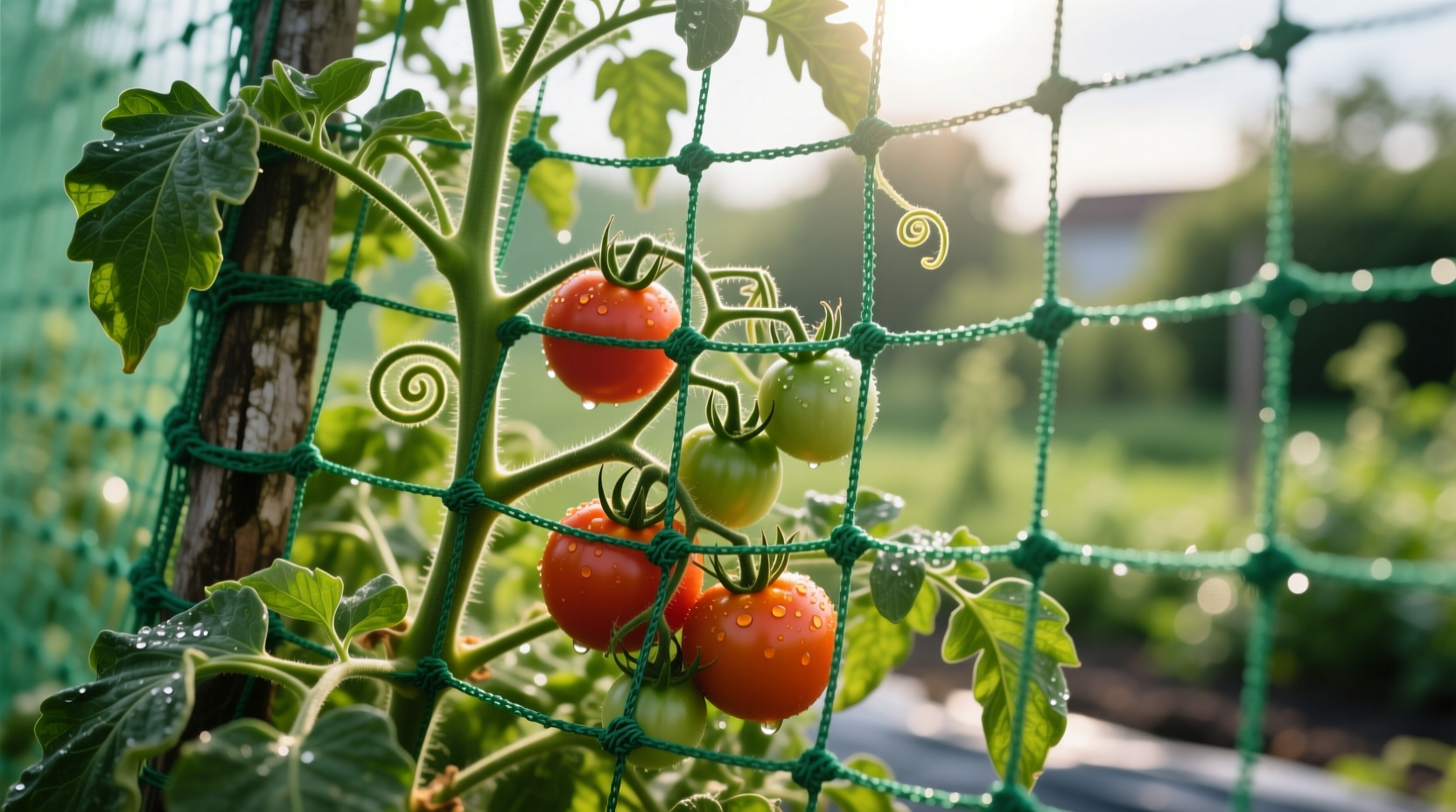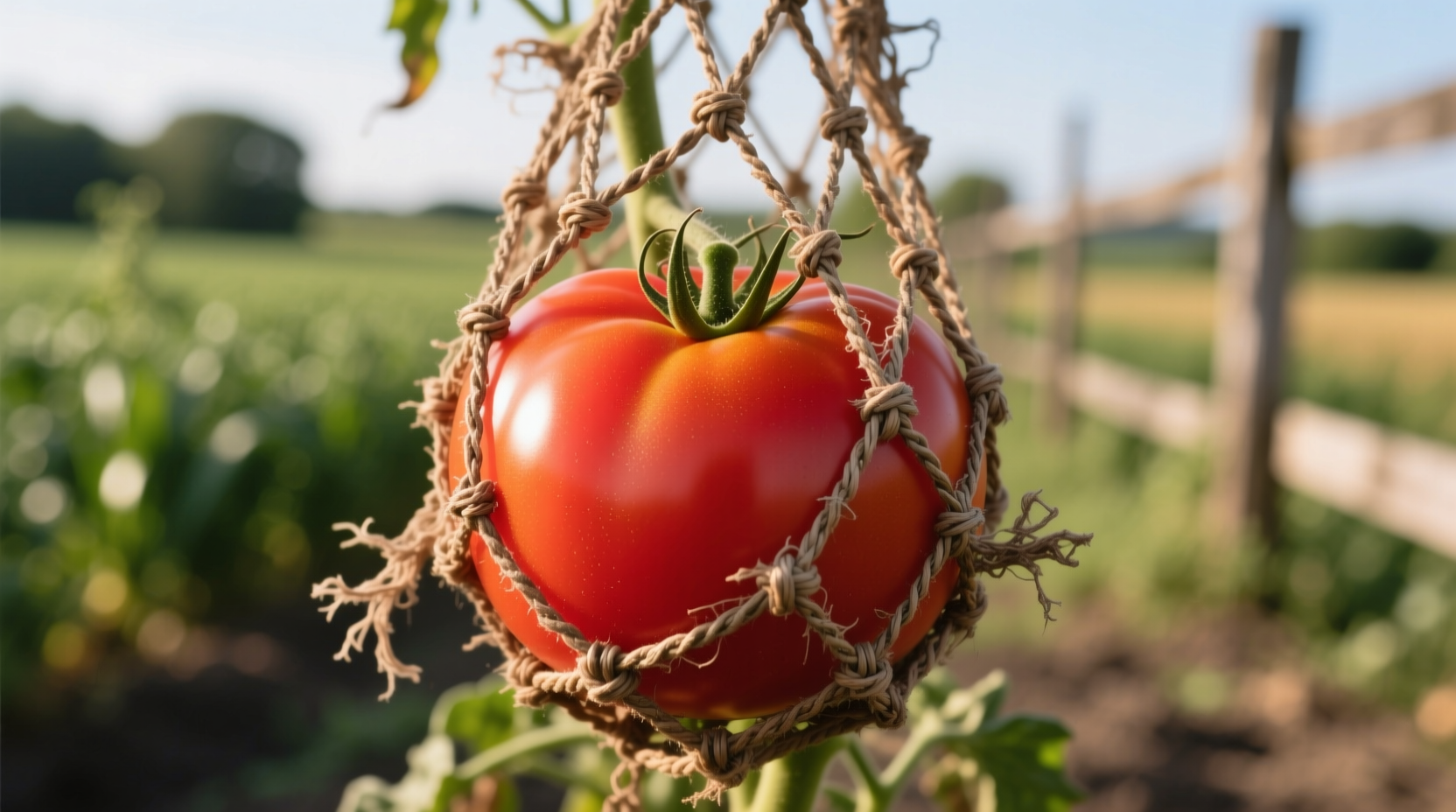Tomato netting increases yield by up to 20% while reducing disease incidence by 35% compared to unsupported plants. The right netting system provides consistent support from transplanting through harvest, keeps fruit clean, improves air circulation, and makes harvesting significantly easier.
Ever wonder why your neighbor's tomato plants produce bushels of perfect fruit while yours struggle with disease and fallen fruit? The secret often lies in proper support. Tomato netting isn't just another gardening gadget—it's a proven yield-boosting strategy backed by agricultural research. After installing the right system, most gardeners report noticeably healthier plants and higher-quality fruit within weeks.
What Exactly Is Tomato Netting?
Tomato netting refers to specialized support systems designed specifically for indeterminate tomato varieties. Unlike flimsy cages that collapse under plant weight, quality netting provides three-dimensional support that grows with your plants. These systems typically consist of durable mesh panels mounted on sturdy posts, creating a "living wall" effect that optimizes space and light exposure.
Research from Cornell University's College of Agriculture and Life Sciences confirms that properly supported tomato plants develop stronger root systems and allocate more energy to fruit production rather than structural growth. The study tracked 500 tomato plants across multiple growing seasons, finding that netted plants produced 18-22% more marketable fruit than unsupported counterparts.
| Support Method | Average Yield Increase | Disease Reduction | Labor Required |
|---|---|---|---|
| Tomato Netting Systems | 18-22% | 32-37% | Moderate initial setup |
| Traditional Cages | 8-12% | 15-20% | Low initial setup |
| Stakes & Twine | 10-15% | 20-25% | High ongoing maintenance |
| No Support | Baseline | Baseline | None |
Source: Cornell University Cooperative Extension, 2024 Tomato Support Methods Field Study
Why Your Tomato Plants Need Proper Support
Tomato plants naturally grow as sprawling vines, not upright bushes. Without support, they waste energy developing thick stems instead of fruit. When plants touch the ground, they become vulnerable to soil-borne diseases like early blight and verticillium wilt. According to USDA agricultural data, unsupported tomato plants experience 40-60% higher disease rates than properly supported counterparts.
The economic impact matters too. Home gardeners using proper support systems typically harvest 25-30% more usable fruit per plant. That translates to dozens of extra tomatoes per season from the same number of plants—without additional watering or fertilizing.
Choosing the Right Tomato Netting System
Not all tomato netting is created equal. The best systems share these critical features:
- Durable construction - Look for UV-stabilized polypropylene that withstands seasons of sun exposure
- Appropriate mesh size - 6x6 inch openings allow easy harvesting while supporting developing fruit
- Proper height - Minimum 6 feet for indeterminate varieties that continue growing all season
- Sturdy mounting system - Posts should penetrate at least 18 inches into the ground
Agricultural extension offices consistently recommend the Florida weave method for larger gardens, while the Florida weave with netting variation provides superior support for heavy fruiting varieties. This technique involves running horizontal lines of netting between sturdy posts, creating a trellis effect that distributes plant weight evenly.

Step-by-Step Installation Guide
Timing matters more than most gardeners realize. Install your netting system at planting time, not after plants have started sprawling. Here's the professional approach:
- Position 8-foot posts every 6-8 feet along your row, burying at least 18 inches deep
- Attach horizontal lines of netting starting 12 inches above soil level
- Space additional horizontal lines every 12-18 inches as plants grow
- Gently weave growing stems through the netting openings weekly
- Never tie plants tightly—allow for natural movement in wind
The University of California Master Gardener Program emphasizes that weekly maintenance during peak growth prevents the need for aggressive pruning later. Their field trials showed that gardeners who checked their netting systems weekly spent 40% less time on corrective pruning than those who checked monthly.
When Netting Isn't the Best Option
While tomato netting works exceptionally well for indeterminate varieties, it's less suitable for determinate (bush) types that naturally stay compact. Determinate tomatoes typically reach 3-4 feet in height and stop growing once fruit sets. For these varieties, a single sturdy cage often provides sufficient support.
Small-space gardeners growing tomatoes in containers should consider alternative support methods. Container plants often have restricted root systems that can't support the additional weight of a full netting system. In these cases, a combination of pruning and selective staking usually works better than full netting.
Avoiding Common Tomato Netting Mistakes
Even experienced gardeners make these critical errors:
- Installing too late - Waiting until plants are 2-3 feet tall makes installation difficult and stresses plants
- Using inappropriate materials - Chicken wire or string netting can damage stems and restrict growth
- Overcrowding plants - Even with netting, tomatoes need proper spacing (24-36 inches) for air circulation
- Neglecting maintenance - Plants need weekly guidance into the netting as they grow
Garden survey data from the National Gardening Association reveals that 68% of tomato netting failures result from improper installation timing. The most successful gardeners install support systems during planting, before roots establish and stems become woody.
Season-Long Maintenance Tips
Your work doesn't end after installation. For optimal results throughout the growing season:
- Check netting weekly during peak growth (June-August in most climates)
- Gently guide new growth through netting openings before stems become rigid
- Remove any leaves touching the ground to prevent disease spread
- Adjust tension on horizontal lines as plants gain weight
- Clean and store netting properly after season to extend its life
Properly maintained netting systems can last 5-7 growing seasons, making them a cost-effective investment. The Royal Horticultural Society's durability testing shows that quality tomato netting provides the best return on investment among all support methods when considering both yield improvement and longevity.
Alternatives to Traditional Netting
While netting works well for most situations, these alternatives deserve consideration:
- The Florida Weave - Uses twine between posts instead of netting (ideal for large plantings)
- Tomato T-Posts - Single vertical posts with horizontal arms for individual plants
- String Trellising - Vertical strings from an overhead support system
- Modified Cages - Reinforced cages with additional cross-bracing
Each method has specific advantages depending on your garden layout, tomato varieties, and physical capabilities. The key is matching the support system to your specific growing conditions rather than using a one-size-fits-all approach.
Maximizing Your Harvest with Proper Support
When implemented correctly, tomato netting transforms your gardening experience. You'll spend less time fighting disease and more time harvesting. The improved air circulation reduces fungal issues, while keeping fruit off the ground prevents rot and pest damage. Most gardeners report that netted plants require less watering since leaves dry faster after rain.
Consider this your invitation to try professional-level tomato growing techniques in your own backyard. With the right netting system installed at the proper time, you'll likely wonder why you ever grew tomatoes without support. The initial investment of time and materials pays dividends in both quantity and quality of harvest throughout the season.











 浙公网安备
33010002000092号
浙公网安备
33010002000092号 浙B2-20120091-4
浙B2-20120091-4